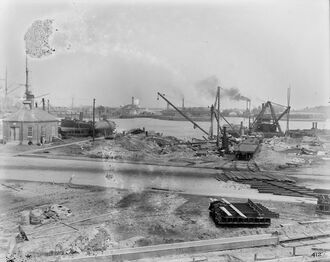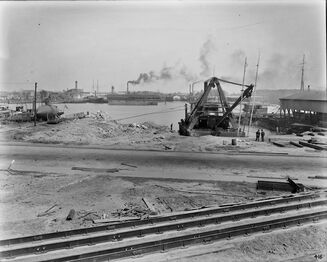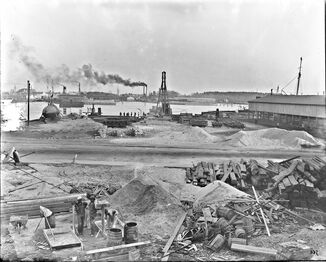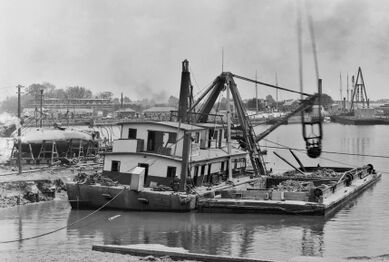A-4

In the background is the incomplete hulk of the Holland submarine Plunger of 1895 (NOT the USS Plunger (Submarine No. 2)). She was built under a Navy contract but was a complete failure and it was never commissioned into the Navy. The boat was also known as the Holland V. Her hulk was retained by the builder until 1917 when she was finally scrapped.
U.S. Navy photo
USS Mocassin (Submarine No. 5) crew muster for April 15, 1910. Data is incomplete due to lost records.
| McWhorter, Ernest D. - Ensign - age 26 - Born: Mississippi |
| Aber, Edward - MM 1c - age 27 - Born: New Jersey |
| Dix, Louis A. - EM 1c - age 23 - Born: Wisconsin |
| Featherstone, James A. - CEM - age 28 - Born: Pennsylvania |
| Leahey, Daniel - CGM - age 28 - Born: New York |
| Littlefield, Roy C. - CMM - age 27 - Born: Massachusetts |
| Mason, Frank L. - EM 2c - age 23 - Born: Massachusetts |
| Purtell, George E. - GM 1c - age 26 - Born: Massachusetts |
| Porter, James - GM 1c - age 29 - Born: Virginia |
| Riley, John - MM 2c - age 23 - Born: West Virginia |
| Woodward, Harry C. - EM 2c - age 22 - Born: New York |
| Wolfington, James H. - GM 1c - age 26 - Born: Illinois |
This view is looking east, across the south branch of the Elizabeth River, with the Berkley district in the background. Dredging and construction work are underway to create a new basin for the mooring of destroyers and surface torpedo boats. In the foreground is a street that used to be called Brown Avenue, but is now called Stevens Street. It is wholly within the perimeter of the current Naval Shipyard.
Not long after these photos were taken, the Moccasin would be returned to service, refurbished, and loaded aboard the collier USS Caesar (Collier No. 16) as deck cargo along with her sister Adder (Submarine No. 3). They would be transported to the Philipines were they would serve out their days with the Asiatic Fleet.
It is interesting to note the presence, in the fourth photo, of the ancient Civil War monitor USS Canonicus (with the number 6 just visible on her bow) sitting in reserve in the background. Canonicus was a single turret monitor, an updated version of the famous Monitor of Civil War fame. Why Canonicus lingered at the Navy yard far after her usefulness to the Navy ended is hard to explain, but since she was still in existence during the Jamestown Exposition of 1907 she was partially refurbished and put on display for the massive crowds that attended the event in Norfolk. Much of the "modern" Navy of 1907 came to the Exposition for the public to see, and Canonicus was hauled out of reserve to provide a link with the glorious past of the the U.S. Navy. Shortly after these photos were taken, Canonicus would be sold for scrap.
Photos courtesy of NARA.
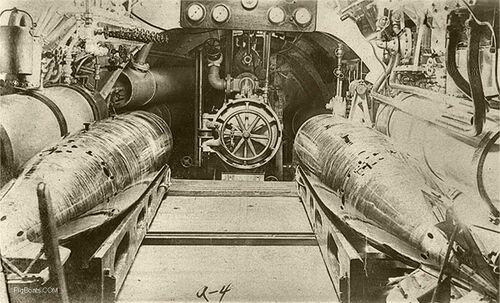
The weapons shown here are Whitehead Mark 3 torpedoes. They were 11.6 feet long and 17.7 inches wide to fit into the tubes of the A-class submarines. They carried a warhead with 118 pounds of wet gun-cotten and had a range of 800 yards at 27.5 knots.
An interesting tidbit is the fan mounted above and to the right of the torpedo tube. Use to provide the crew with some air circulation and cooling. It also prevented the accumulation of hydrogen gas to pocket in one place as the battery out-gassed during charging.
The interior of the A-class boats was one large space with no bulkheads. Where this photo was taken from is approximately the center of the submarine. Below the deck seen in this photo is the ship's storage battery used for electrical power for lighting and propulsion while submerged. The battery is covered by wood planks and then has a canvas covering that is stretched tight and then shellacked in place or may be painted to make it watertight.
U.S. Navy photo
Page created by:
Ric Hedman & David Johnston
1999 - 2023 - PigBoats.COM©
Mountlake Terrace, WA, Norfolk, VA
webmaster at pigboats dot com

